Charles Darden has collected carbines for almost a half century—and he doesn’t have any plans to stop.
Darden might have focused on the unique firearm exclusively. But that changed in August 2009. He was in a Richmond, Va., parking lot, preparing to leave empty-handed from the North South Trader’s Civil War Show. He hadn’t found a carbine that struck his fancy. Then, he struck up a conversation with a young man.
“He asked me if I wanted to buy an image. I told him I was a carbine collector and it went from there,” Darden remembers. When all was said and done, he drove off with the photograph, a Missouri cavalryman.
“I was hooked,” Darden admitted. “Hell, I could have bought a carbine for what I paid for that image!”
He did not soon forget the experience. The young man who had such a profound influenced on him that day, Rick Brown, one of the country’s top collectors and an MI senior editor. Darden notes, “To this day Rick and I are friends.”
Born in Suffolk, Va., Darden has two ancestors that fought for Virginia and the Confederacy. His great-great grandfather Elisha Rawls served in Company K of the 41st Infantry. His great-great-uncle Julius Caesar Darden served in Company D of the 16th Infantry, and suffered wounds at the battles of Malvern Hill at Spotsylvania Court House, the latter injury claiming his arm.
Darden became a devoted student of the Civil War while attending Elon College in North Carolina. At an antique shop, he discovered an original set of Battles and Leaders of the Civil War, the acclaimed four-volume series based on original accounts published in Century magazine in the 1880s.
Collecting weapons soon followed, with carbines emerging as a favorite.
Years later, in 1999, Darden purchased his first photograph at another antique shop. But it wasn’t until a decade later that he became serious about Civil War era photography.
“I simply buy what I like, such as soldiers, women and children of that period,” Darden states. “I have met some very knowledgeable people and I want to thank all of them who have shared their wisdom with me.”
Representative images from his collection are published here.

A clean-shaven Confederate grips his Model 1843 Hall Carbine, a rare breech-loader that dates from the Mexican War era. The unique design included the side lever visible here. The soldier also carries a derringer and another small-caliber revolver in his waist belt, fastened with double-roller buckles. His gray frock coat with cut back cuffs trimmed in black suggests Tennessee origins. His Pattern 1839 wheel-hat may be of Mexican War vintage. The image was discovered in Missouri.

At attention with a Pattern 1853 Enfield Rifle musket by his side, this federal infantryman carries a Sheffield style knife and a Model 1849 Colt revolver tucked into his waist belt. The interior pockets of his four-button frock coat are crammed with items, including what appears a pipe on the right side. His military appearance imparts a stark contrast to the elaborate backdrop painted with a veranda and romantic landscape.
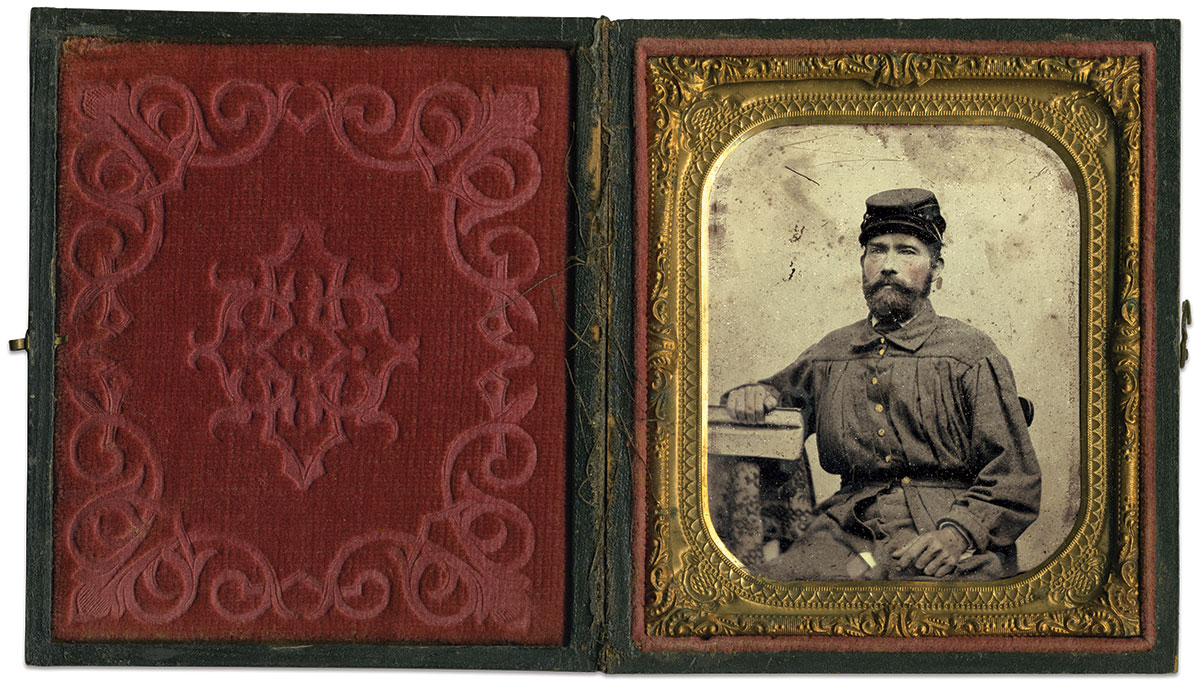
The pleated hunting shirt worn by this enlisted man soldier is similar in style to those worn by South Carolina companies, such as the Richland Volunteer Rifle Company and the Rhett Guard of the 1st South Carolina Infantry commanded by Col. Maxcy Gregg. The soldier is significantly older than the average enlisted man, as evidenced by the wrinkles around his eyes. The thick book he rests his forearm on may be a Bible. His hand apparently marks a specific chapter and verse.
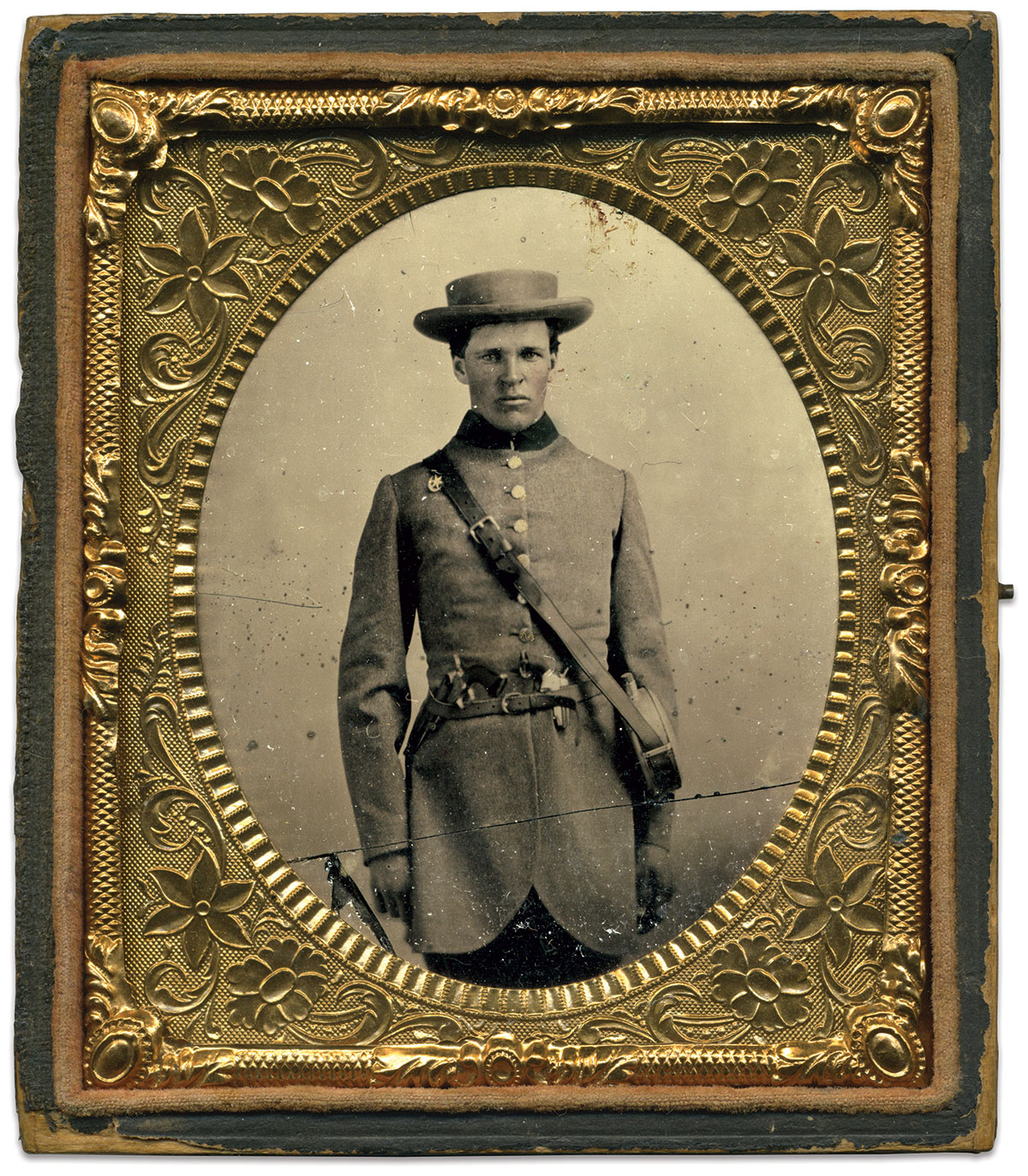
The canteen carried by this soldier, with its convex front and flat back, was uniquely Confederate in its design and production. The star and crescent pin also strikes a Southern chord, which suggests a New Orleans connection. He wears an eight-button frock coat with a dark collar, and a civilian waist belt into which is tucked what appears a Model 1849 Colt or a Model 1851 Colt Navy revolver, and a Sharps four-barrel Pepperbox pistol.

The three straps crisscrossed on the chest of this Confederate indicate he has been fully equipped for camp and campaign. The thin leather strap on top supports his canteen. The thicker leather strap with the breastplate connects to his visible cartridge box. His haversack connects to the end of the third strap, made of canvas. His uniform appears regulation, and his flat-crowned slouch hat is common to Confederate soldiers.

Choctaw County, Miss., was ably represented in the Confederate army by this trio of kin who served in the Choctaw Guards, which became Company I of the 15th Mississippi Infantry. In the center sits James L. Powers (1841-1916), who suffered a serious knee wound during an undisclosed engagement. His brother, William Hooker Powers (1843-1913), left, and a cousin, William Thomas Powers (1841-1890), flank him. All three boys moved to Mississippi from their native South Carolina. The 15th served in various locations in the Trans-Mississippi, and also fought in the Atlanta Campaign.

The Union soldier in this portrait appears in sharp relief compared to the rest of his family in soft focus. The effect created by the limitations of the photographer’s lens perhaps serves as a metaphor for the separation that they would soon face when he left for duty in the South.
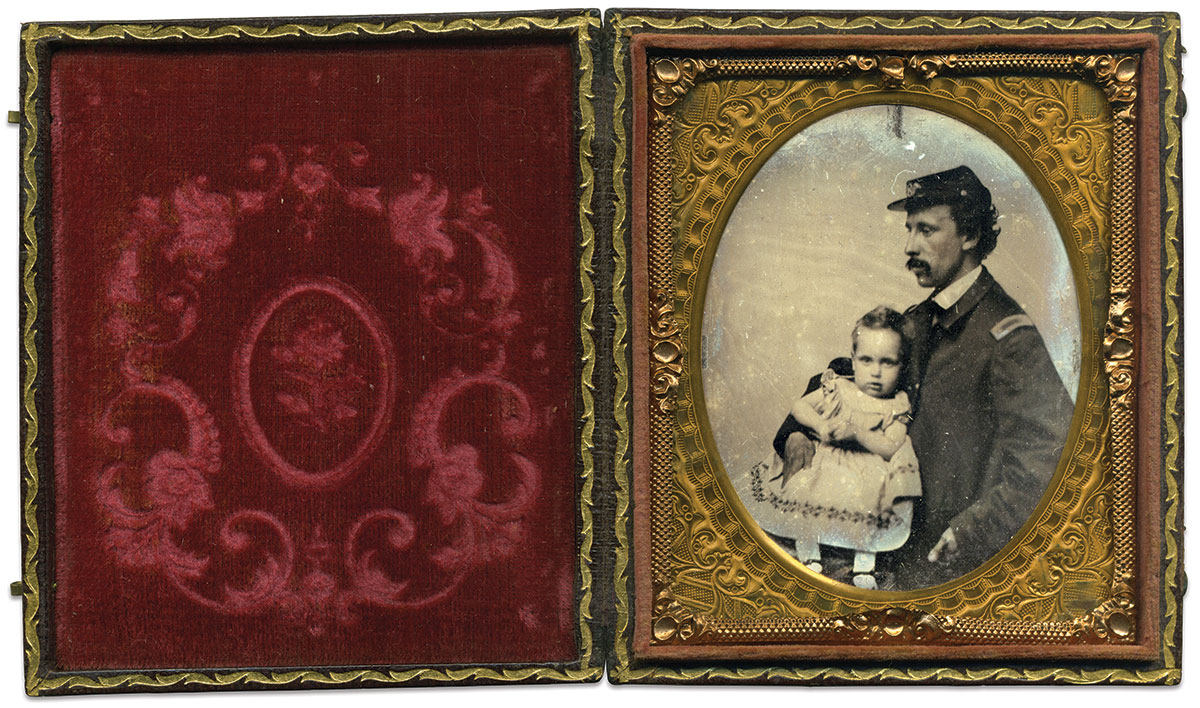
With a downcast glance toward the child cradled in his arm, one wonders what was on this federal infantry lieutenant’s mind. Would he return home? What would become of the country or his child’s future happiness? For all too many soldiers and sailors on both sides of the conflict, the answers to these questions proved tragic.

A quintessential early war Union infantryman is fully loaded with likely new gear. His Model 1861 Springfield musket with bayonet attached has its wooden tampion in the muzzle of the barrel to prevent moisture from forming. He carries a standard issue canteen with cover, cartridge box, haversack and knapsack with leather straps and blanket. His Hardee hat is worn as a slouch hat, with a crease at the top that pulls in the sides, and without the eagle to secure the left side of the brim. The insignia is simply the regimental number 45—the infantry horn and company letter is not attached. The unusually long skirts of his frock coat is perhaps the work of a uniform maker unfamiliar with the standard that called for a skirt that extended “one-half the distance from the top of the hip to the bend of the knee.”
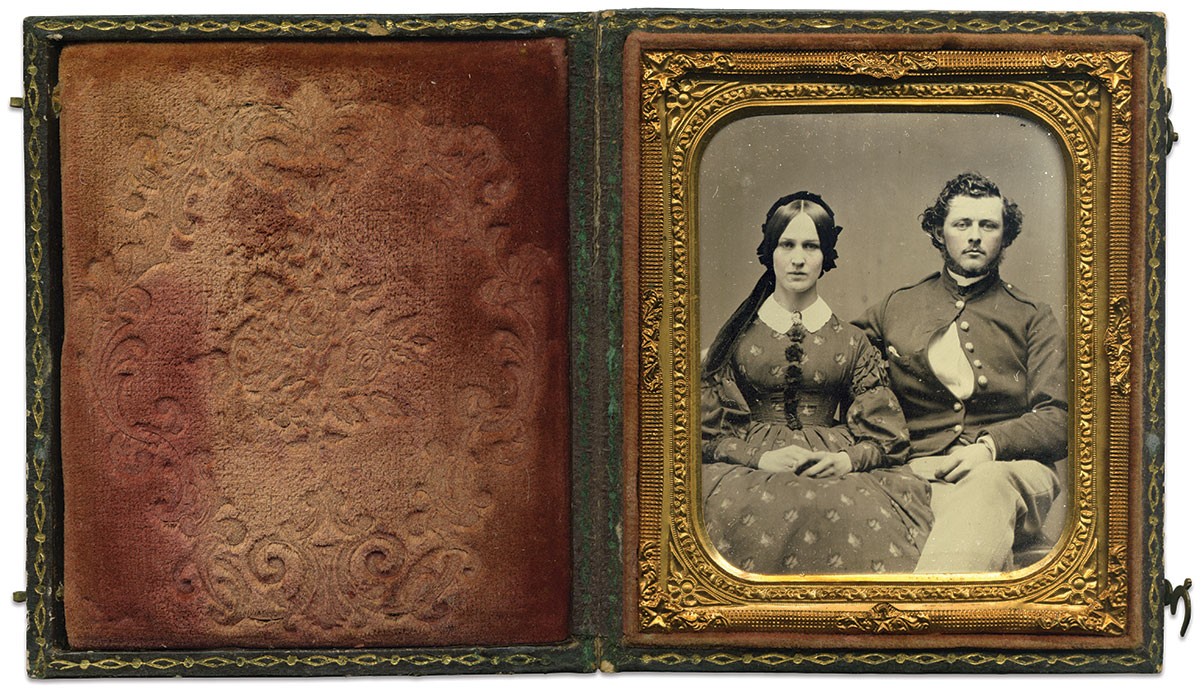
She sits in almost perfect symmetry, with her hands clasped, and dressed in a maple-leaf patterned outfit and a dark bonnet. The broach that secures her collar contains an image of a young woman, perhaps an angel, with flowing locks of golden hair. Her beau, likely her husband, his hair quaffed and sporting a neatly trimmed beard, looks ever so slightly askance. His starched white shirt, silk tie and pristine New York uniform coat suggests he has yet to experience the hardships of war.

Hand-lettered initials on the canteen cover carried by this young Union infantryman appear to spell U.S. He stands here cradling a U.S. Model 1842 smoothbore musket with bayonet attached, and wears a knapsack with his very visible gum blanket. Civilian pants and a fancy vest with two columns of buttons offset his very military appearance. Conspicuously absent are his cartridge box, waist belt with cap box, and bayonet scabbard. The missing items might be explained by the simple fact that he had only been issued a portion of his equipment at the time he posed. Another possibility: The gear he wears is photographer’s props.
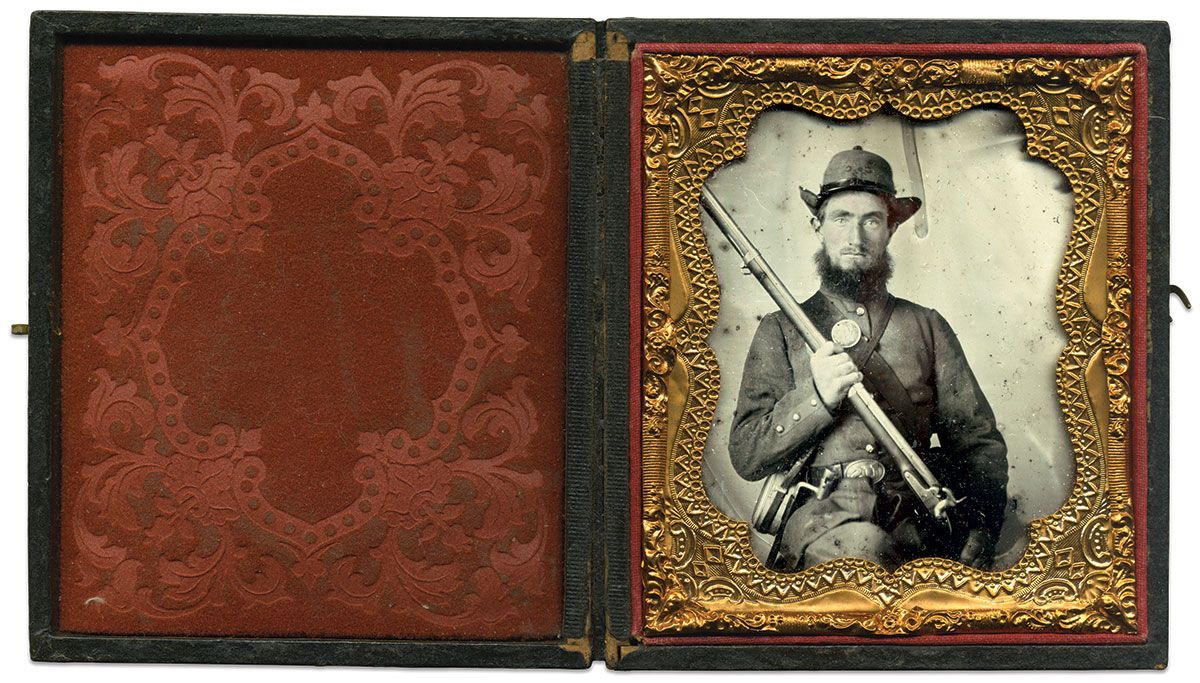
This musket-wielding federal wears the distinctive Havelock hat produced by Chicago hatter James Loomis. Designed for comfort with an adjustable brim to protect the head and neck from the elements, the hat was distributed by the government of Illinois to some of its troops. The one worn by this soldier bears his unit designation—Company C of the 32nd Infantry. His uniform, state issue gray trimmed in light blue, is not known to have been worn by the 32nd, but by five other regiments, the 8th through the 12th, organized for three months in early 1861. The uniform may have been surplus. Or perhaps, this soldier had just completed his three-month stint in one of the early regiments and reenlisted in the 32nd, clad in his new Havelock hat and old uniform.

The well-known signature of noted Richmond photographer Charles R. Rees is scratched into the emulsion of this Southern exposure. The soldier appears in a triple-breasted coat common to early war regiments, and a tall black felt hat with a curved brim. The belt around his waist is secured with a large variant of the “wishbone” or “forked tongue” Confederate frame buckle. Also visible is a cap pouch and bayonet scabbard. The musket at his side is the U.S. Model 1816 (Type II), also known as the U.S. Model 1822. Most of these weapons were altered from flintlock to percussion in the 1850s.
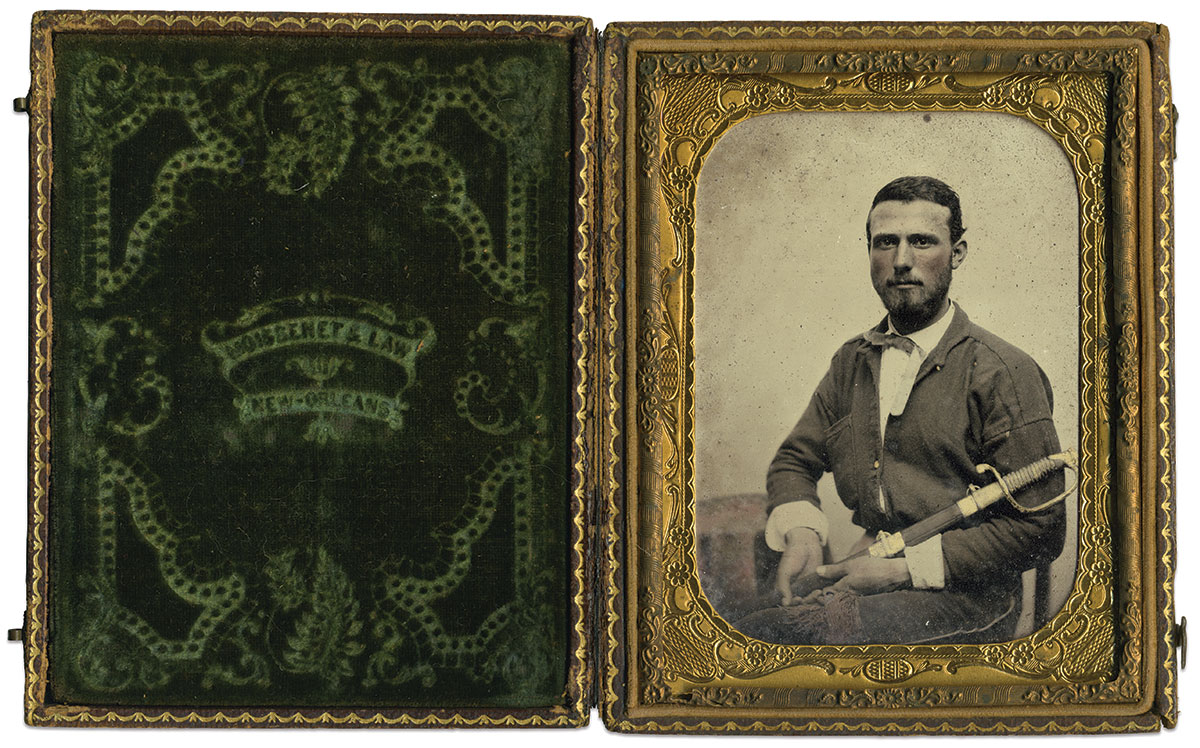
A bearded soldier who cradles a Model 1850 Foot Officer’s sword wears a comfortable sack coat with a generous pocket, and dark pants with a thin stripe. Considering the simplicity of his uniform and the absence of insignia, his allegiance is anyone’s guess. The photographer stamp on the velvet lining inside of case, believed original to the image, reveals an important clue to his loyalty. The photographers, Felix Moisennet and Frederick Law, were partners in a New Orleans gallery from 1856-1858. The soldier is likely a U.S regular or perhaps a militiaman. Whether or not he decided to remain a Union soldier after the bombardment of Fort Sumter in 1861 remains an open question.

The personalized leather strap and cartridge box identifies the owner of this Model 1842 French rifled musket as W. Hunt. According to the Civil War Research Database, 284 volunteer enlistments with this first initial and last name are recorded. The vast majority were, like this soldier, enlisted men.

This pair of portraits captures the transition of a peacetime civilian to a Union soldier—a scenario that occurred on a massive scale during the Civil War. His wears a four-button sack coat and a cap with the company letter D affixed to the front. His cap box and cartridge box are standard issue. The Model 1842 French Infantry smoothbore musket in his hands was used by Northern and Southern troops.

The British Pattern 1851 Minié rifle held by this Southern soldier represented cutting edge technology during the Crimean War (1854-1856). But its heyday was brief, as the introduction of the Pattern 1853 Enfield rifle musket soon became standard issue to British infantry. The Minié rifles were placed in storage until late 1861, when the fledgling Confederate government purchased about 15,000 of them. An estimated 11,000 made it into hands of Confederate infantrymen, including this man, beginning in January 1862. Most saw hard use through the rest of the Civil War.
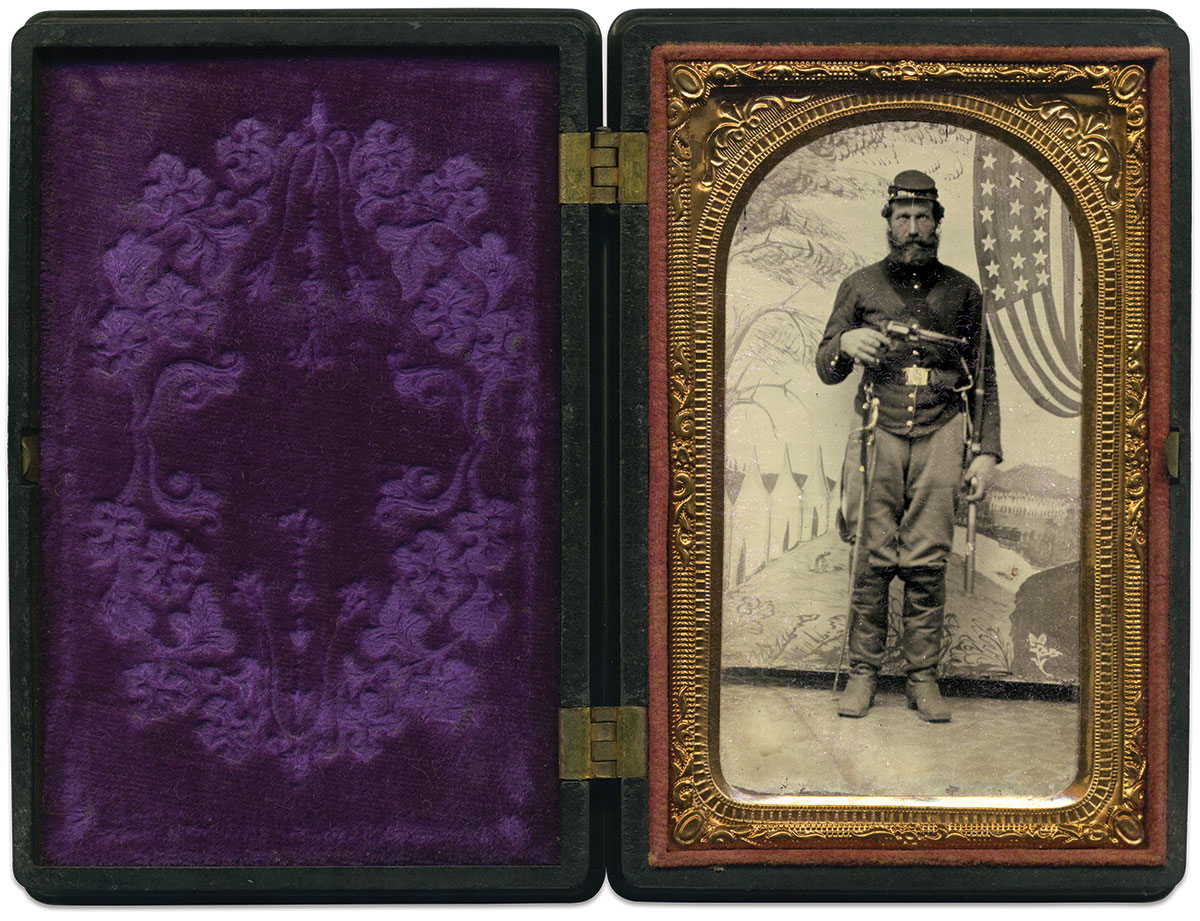
A cavalry trooper stands at the ready with a full complement of weapons appropriate to his branch of the service. They include a Burnside carbine, a Whitney or Remington revolver and a Model 1860 saber. He poses before an elaborately painted backdrop that depicts a sprawling tenting ground beneath the Star-Spangled Banner.

Resting drumsticks on the head of his base drum, this soldier carries a musician’s sword suspended by a non-commissioned officers’ cross belt with an eagle breastplate. Everything about his uniform says Government Issue, with the exception of his private-purpose McDowell-style cap, which he likely purchased for comfort.

A sergeant of artillery showcases his Model 1832 Foot Artillery sword, the point of which likely resting on a table. The manner in which he displays the sword, in the foreground, front and center, suggests that a story lost in time. He also carries a Model 1851 Colt Navy revolver tucked into his waist belt.
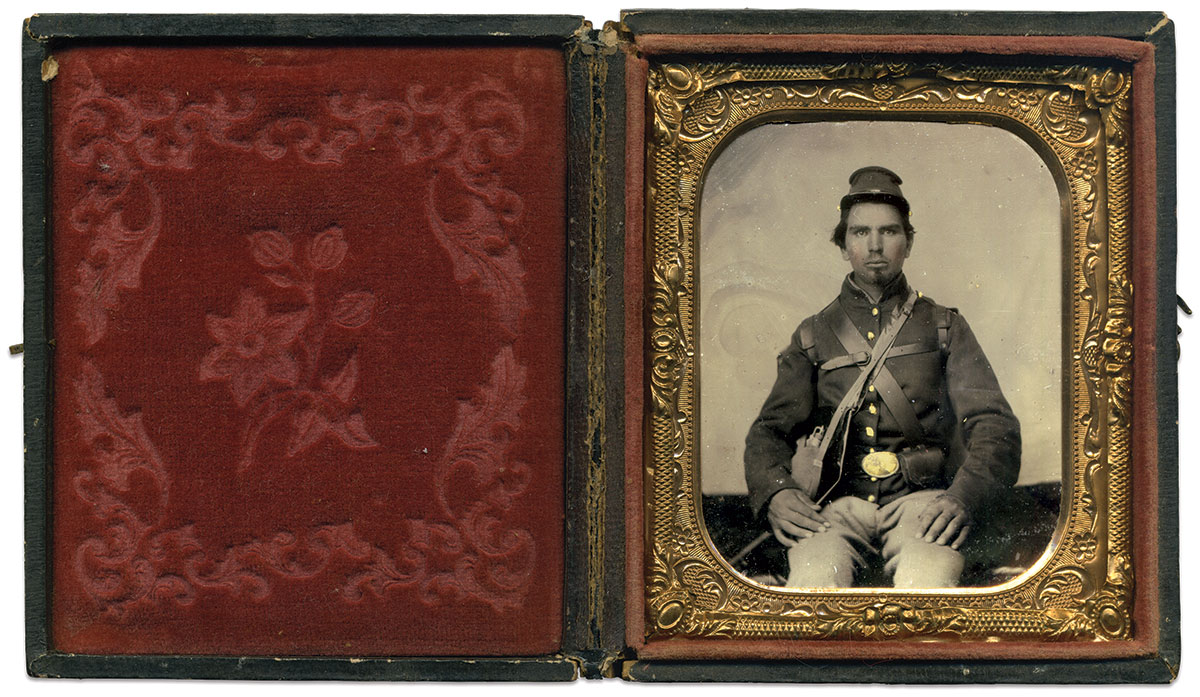
The untrimmed shell jacket with piping worn by this Union volunteer is often seen in early war portraits of Ohio or Illinois soldiers. He is fully equipped and ready for the march with his canteen with leather strap and roller buckle. Below the canteen, a weatherproofed haversack and the edge of a bayonet suggest that he set aside his musket rather than pose with it. Just visible are the edges of his knapsack, held in place by leather arm slings and a chest belt adjusted by a roller buckle.

Though New York uniforms are generally well documented, unknown variations such as the coat worn by this young soldier continue to surface. Made of gray, trimmed in red and decorated with a tombeau pattern mid-waist, the wearer is Irish immigrant Christopher W. Campbell. He was all of 15 years old when he enlisted in the Union army in October 1861. He joined the Irish Brigade, appropriately, as a musician in Company F of the 63rd New York Infantry. His service was cut tragically short on March 12, 1862, by an accidental shot while on the march to Manassas, Va., He succumbed to his wound nine days later.
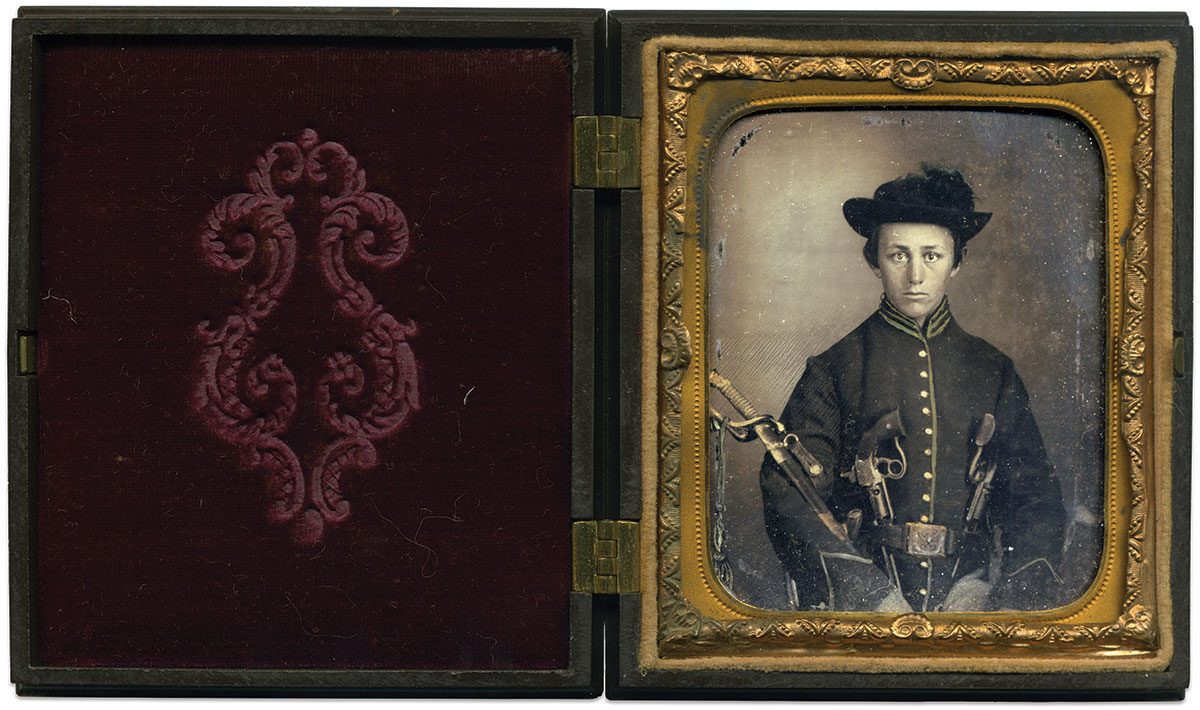
A pair of Savage North Navy Model percussion revolvers dominates this portrait of a clean-shaven cavalryman. Only about 20,000 of these distinctive arms were produced during the early part of the war, and wound up in the hands of troopers on both sides of the conflict. The revolvers are tucked into a waist belt fastened by a U.S. Model 1851 officer’s belt plate. He holds a Model 1850 Foot Officer’s sword, an unorthodox choice for a cavalry soldier.

The long list of casualties from the firestorm that devastated Confederate Maj. Gen. George E. Pickett’s division at the Battle of Gettysburg included Zachariah Angel Blanton. Blanton enlisted as a sergeant in the Farmville Guards in 1861. He sat for this portrait wearing a cap with the letters FG, and armed with a Model 1816 conversion musket. The Guards became Company F of the 18th Virginia Infantry. By 1862, he advanced to captain and company commander. Blanton fought in this capacity at Gettysburg. During Pickett’s Charge, he suffered a gunshot wound that caused massive damage to the right side of his face—a significant section of his upper jaw was destroyed and his tongue injured. Captured on the field of battle, he spent the next 10 months as a prisoner of war at Johnson’s Island, Ohio, and elsewhere. Blanton was exchanged in mid-1864, and retired from the service on account of his wounds. He returned to Virginia, married in 1868, and started a family that grew to include three children. He died in 1893.
SPREAD THE WORD: We encourage you to share this story on social media and elsewhere to educate and raise awareness. If you wish to use any image on this page for another purpose, please request permission.
LEARN MORE about Military Images, America’s only magazine dedicated to showcasing, interpreting and preserving Civil War portrait photography.
VISIT OUR STORE to subscribe, renew a subscription, and more.

